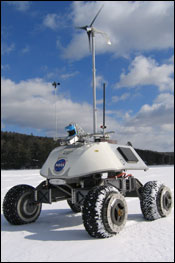 It's surprising to me that scooters aren't more popular in the US. After all, scooters can handle the distance and hills of suburbia more easily than bicycles, and can wind through jammed city streets (and find parking) pretty effortlessly. They don't have the power and machismo of motorcycles, true; perhaps they'd be more popular if they were seen not as weak cousins of motorcycles, but as showing how future bikes might evolve.
It's surprising to me that scooters aren't more popular in the US. After all, scooters can handle the distance and hills of suburbia more easily than bicycles, and can wind through jammed city streets (and find parking) pretty effortlessly. They don't have the power and machismo of motorcycles, true; perhaps they'd be more popular if they were seen not as weak cousins of motorcycles, but as showing how future bikes might evolve.
Honda seems to be taking that path, as it is exploring bringing both hybrid-electric and fuel cell technologies to its scooter line, and is promoting them on its motorcycle web page. The 50cc hybrid scooter gets 60% better mileage than the standard 50cc gas model; the fuel cell model is bigger (125cc), and runs on the same fuel cell stack used in their FCX car. Both are prototypes, naturally; if it turns out there's little interest in hybrid or fuel cell scooters, Honda never has to mention them again...
But what if you do want an advanced technology scooter?
Vectrix is now making the VXe, an all-electric scooter, and has plans to introduce a fuel cell model real soon now. The Honda scooters, while nicely styled, still look like scooters; the Vectrix VXe, conversely, looks like the offspring of a sport motorcycle. It's big -- almost 200 kg in weight -- and maxes out at 100 km/h, almost enough to take on the freeway, and certainly enough to scoot down city and suburban streets with confidence. At least until your battery runs out, that is. As with all currently-available electrics, range remains an issue. Even with regenerative braking adding charge back to the battery, the VXe only goes about 68 miles, less if you drive close to top speed.
Still, it's good to see this kind of technology exploration. It's entirely possible that the limited range of an electric is a non-issue for most scooter riders. Abundant interest in the VXe could, in turn, prompt Honda (and other makers of scooters and motorcycles) to bring their prototypes to market. Scooters are wildly popular around the world: in Taiwan, for example, there are 10 million scooters for a population of 23 million people; Italy has 6 million; China bought 10 million and India bought 3 million in 2000 alone. It wouldn't be a bad idea to start to turn those numbers green.
 Phytoplankton -- microscopic plant forms floating in the oceans -- are the closest thing on the planet to the underlying fuel for life. Phytoplankton are at the base of the marine food chain, and produce around half of the oxygen in our atmosphere. We know that they bloom and are consumed quickly; phytoplankton have an annual production comparable to all terrestrial plants on Earth. Up until now, however, nobody had figured out a way to determine precise phytoplankton growth rates.
Phytoplankton -- microscopic plant forms floating in the oceans -- are the closest thing on the planet to the underlying fuel for life. Phytoplankton are at the base of the marine food chain, and produce around half of the oxygen in our atmosphere. We know that they bloom and are consumed quickly; phytoplankton have an annual production comparable to all terrestrial plants on Earth. Up until now, however, nobody had figured out a way to determine precise phytoplankton growth rates.
 We pay attention to the growth of distributed computing efforts for a few reasons: they're quite often projects with distinctly worldchanging aspects, whether trying to figure out
We pay attention to the growth of distributed computing efforts for a few reasons: they're quite often projects with distinctly worldchanging aspects, whether trying to figure out  Hydrogen fuel cell cars are getting closer and closer to usability. At the Geneva Motor Show, DaimlerChrysler introduced its Mercedes-Benz B-Class fuel cell car, which uses the same external frame as its popular-in-Europe B-Class compact car.
Hydrogen fuel cell cars are getting closer and closer to usability. At the Geneva Motor Show, DaimlerChrysler introduced its Mercedes-Benz B-Class fuel cell car, which uses the same external frame as its popular-in-Europe B-Class compact car.  It's surprising to me that scooters aren't more popular in the US. After all, scooters can handle the distance and hills of suburbia more easily than bicycles, and can wind through jammed city streets (and find parking) pretty effortlessly. They don't have the power and machismo of motorcycles, true; perhaps they'd be more popular if they were seen not as weak cousins of motorcycles, but as showing how future bikes
It's surprising to me that scooters aren't more popular in the US. After all, scooters can handle the distance and hills of suburbia more easily than bicycles, and can wind through jammed city streets (and find parking) pretty effortlessly. They don't have the power and machismo of motorcycles, true; perhaps they'd be more popular if they were seen not as weak cousins of motorcycles, but as showing how future bikes  How do you handle the outbreak of a highly infectious disease?
How do you handle the outbreak of a highly infectious disease? Want to buy a solar-powered condo? Developer
Want to buy a solar-powered condo? Developer  As biomedical technologies get cheaper, it becomes easier for non-specialists to get access to them; as the technologies get "smarter," it becomes easier for non-specialists to use those them. We see this happening with devices such as inexpensive defibrillators, now standard issue on many airplanes, which are sufficiently automated to allow people with no medical knowledge to save the lives of heart attack victims in mid-air. This is pretty clearly a good thing. But we're also now seeing this happen with genetic testing, and whether or not it's for the good remains to be determined.
As biomedical technologies get cheaper, it becomes easier for non-specialists to get access to them; as the technologies get "smarter," it becomes easier for non-specialists to use those them. We see this happening with devices such as inexpensive defibrillators, now standard issue on many airplanes, which are sufficiently automated to allow people with no medical knowledge to save the lives of heart attack victims in mid-air. This is pretty clearly a good thing. But we're also now seeing this happen with genetic testing, and whether or not it's for the good remains to be determined. Several stories popped up over the last week of relevance to the continued evolution of the participatory panopticon:
Several stories popped up over the last week of relevance to the continued evolution of the participatory panopticon:

 This week's Nature also includes an outstanding editorial by Keith Alverson, "
This week's Nature also includes an outstanding editorial by Keith Alverson, "
 How do you know when an ecosystem is dying? Discovering species on the edge of extinction -- or already past the edge -- doesn't always give the bigger picture. Changes to a region will affect different species in different ways, letting some flourish even as others die.
How do you know when an ecosystem is dying? Discovering species on the edge of extinction -- or already past the edge -- doesn't always give the bigger picture. Changes to a region will affect different species in different ways, letting some flourish even as others die.
 The German magazine Spiegel has an
The German magazine Spiegel has an  Carnegie-Mellon's sensor-laden Nomad robotic explorer, which traveled 135 kilometers across Chile's Atacama desert in 1997, is set to take on a new adventure. It's going to be
Carnegie-Mellon's sensor-laden Nomad robotic explorer, which traveled 135 kilometers across Chile's Atacama desert in 1997, is set to take on a new adventure. It's going to be  We've been
We've been  Not only can you drive hybrids for green self-satisfaction, you can light your building with hybrids, too. Hybrid lighting, that is, a new technology from the Oak Ridge National Laboratory. The system pipes sunlight throughout a building, providing useful levels of light whenever the sun is out. But on cloudy days, or at night, the lighting fixtures turn on fluorescent tubes to supplement the output -- that's the "hybrid" part. The system can even capture light for power generation.
Not only can you drive hybrids for green self-satisfaction, you can light your building with hybrids, too. Hybrid lighting, that is, a new technology from the Oak Ridge National Laboratory. The system pipes sunlight throughout a building, providing useful levels of light whenever the sun is out. But on cloudy days, or at night, the lighting fixtures turn on fluorescent tubes to supplement the output -- that's the "hybrid" part. The system can even capture light for power generation.  Last month, the Massachusetts Institute of Technology inaugurated its
Last month, the Massachusetts Institute of Technology inaugurated its  This month's Technology Review has a fascinating set of stories about how technological development and problems are viewed in seven different countries:
This month's Technology Review has a fascinating set of stories about how technological development and problems are viewed in seven different countries: 



 The
The  Can landfills be reimagined as a resource? The people behind the
Can landfills be reimagined as a resource? The people behind the  We've talked quite a bit about the
We've talked quite a bit about the  Peak Oil -- Hubbard's Peak -- Peak Energy -- no matter what you call it, the notion that we will be at maximum oil production far sooner than anyone thought has caught fire of late, with a series of reports popping up in the industrial, environmental, and mainstream press. Some of these have been triggered by crude oil prices once again popping up above $55/barrel, flirting with an absolute record price (although still nowhere close to 1980's dollar-adjusted price of above $80/barrel). But the biggest peak oil news has to be the report coming from the analysts at
Peak Oil -- Hubbard's Peak -- Peak Energy -- no matter what you call it, the notion that we will be at maximum oil production far sooner than anyone thought has caught fire of late, with a series of reports popping up in the industrial, environmental, and mainstream press. Some of these have been triggered by crude oil prices once again popping up above $55/barrel, flirting with an absolute record price (although still nowhere close to 1980's dollar-adjusted price of above $80/barrel). But the biggest peak oil news has to be the report coming from the analysts at  Did you, like me, miss seeing Alex & Bruce deliver the closing keynote at last week's South by South West Interactive conference? Emily, Dawn and Jon wrote a
Did you, like me, miss seeing Alex & Bruce deliver the closing keynote at last week's South by South West Interactive conference? Emily, Dawn and Jon wrote a  There are two major characteristics of the world I've called the "Participatory Panopticon:"
There are two major characteristics of the world I've called the "Participatory Panopticon:" 
 Is a
Is a  Wind and solar power will certainly be part of the bright green future, but they may be overshadowed by hydrokinetic power -- electricity generated from the movement of water.
Wind and solar power will certainly be part of the bright green future, but they may be overshadowed by hydrokinetic power -- electricity generated from the movement of water.  Just in time for
Just in time for 
 The current issue of Nature includes a report by
The current issue of Nature includes a report by  Last week, Alex wrote about the
Last week, Alex wrote about the  Almost a year ago,
Almost a year ago,  Wired magazine's
Wired magazine's  German chemical company BASF has developed a new form of building insulation, and is testing it in a complex of employee houses. The insulation, along with high-efficiency windows and other energy-saving features, results in the buildings requiring only about one liter of oil per square meter for annual heating -- 5% of the average home requirement in Germany, and well below the nation's new efficiency mandate of 7 liters per square meter. The new form of insulation?
German chemical company BASF has developed a new form of building insulation, and is testing it in a complex of employee houses. The insulation, along with high-efficiency windows and other energy-saving features, results in the buildings requiring only about one liter of oil per square meter for annual heating -- 5% of the average home requirement in Germany, and well below the nation's new efficiency mandate of 7 liters per square meter. The new form of insulation?

 We
We  One way to avoid
One way to avoid 
 Here's a fascinating bit of alt-energy technology:
Here's a fascinating bit of alt-energy technology:  We've
We've  The
The  The average garbage truck gets about three miles per gallon, mixing long-haul trips to and from dumps with short start-and-stop pickups, invariably with the diesel engine idling. Garbage is picked up on schedules, not necessarily when the cans are full -- which could be well before or well after the scheduled stop. Our whole system of material use and disuse is due for a revolution; in the meantime, we can look for piecemeal improvements.
The average garbage truck gets about three miles per gallon, mixing long-haul trips to and from dumps with short start-and-stop pickups, invariably with the diesel engine idling. Garbage is picked up on schedules, not necessarily when the cans are full -- which could be well before or well after the scheduled stop. Our whole system of material use and disuse is due for a revolution; in the meantime, we can look for piecemeal improvements.
 If you even come close to the sustainable blogosphere (as I increasingly see it called) today, you know that the UN's
If you even come close to the sustainable blogosphere (as I increasingly see it called) today, you know that the UN's